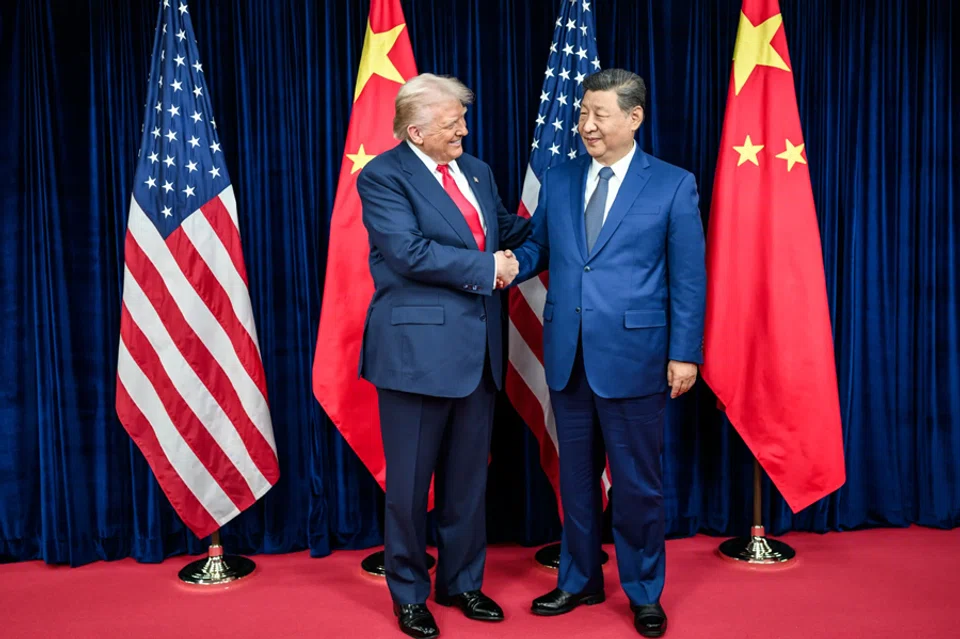
In late October 2025, U.S. President Donald Trump and Chinese President Xi Jinping met in Busan, South Korea on the sidelines of the APEC summit. This was their first in-person encounter since Trump’s return to office that January and the first face-to-face meeting since 2019. Trump described the talks as “amazing”, rating them “12 out of 10” on his own scale. Xi likewise praised steady relations, saying the two countries should “stay on the right course” as partners and jointly shoulder major challenges. The relaxed tone, punctuated by firm handshakes and praise, capped a high-stakes summit expected to break the recent cycle of tit‑for‑tat tariffs between the world’s two largest economies .
Key Agreements and Trade Measures
Tariff Reductions: Trump agreed to roll back some of his latest tariffs on China. In particular, he halved the special 20% “fentanyl tariff” on Chinese imports back to 10%, cutting his overall U.S. tariff rate on China to about 47% (down from 57%). This concession was linked to Chinese action on drug trafficking: Trump said Xi would work “very hard” to block illicit fentanyl flows into the U.S.. In practical terms, many of the pending tariff hikes that had threatened to push U.S. rates on China to 145% in spring 2025 are now suspended under the truce. Economists note that American consumers and importers should see some relief from these cuts, even as tariffs on many Chinese goods remain high .
Rare Earths Export Controls: China agreed to pause its new export restrictions on rare-earth metals and related processing equipment for one year. Rare earths, key components in electronics, green technologies and defense equipment, had become a major leverage point. Trump triumphantly declared “all of the rare earth has been settled” and vowed “there is no roadblock at all on rare earth” for now. In effect, Chinese firms will resume supplying these critical minerals worldwide for at least the next year, a reprieve that EU and U.S. manufacturers will welcome. (Western analysts note that China may still re-impose controls later, but the 12-month pause creates a predictable window for business planning .)
Agriculture and Energy Purchases: Beijing also agreed to ramp up purchases of U.S. agricultural and energy products. According to U.S. officials, China will buy at least 12 million metric tons of U.S. soybeans before January 2026 and then 25 million tons per year for the following three years. Trump celebrated this as a boon for American farmers. In addition, both sides said they would pause new port fees on each other’s vessels (fees aimed at shipbuilding/logistics) and open talks on U.S. oil and gas sales. Trump hinted China would begin buying U.S. energy (including Alaskan LNG) and possibly join an Alaska pipeline project. These deals inject fresh U.S. exports into the Chinese market, even as Beijing’s leaders emphasize broad supply stability .
Technology and TikTok: The U.S. announced a suspension of some new export controls (e.g. the Entity List rules) for one year. On the controversial Chinese-owned app TikTok, China “will work with the U.S. to properly resolve issues” and move toward a sale to U.S. buyers. Trump said a final TikTok deal “will be finalised” at the summit. He also raised the topic of advanced chips: China reportedly will engage with Nvidia to purchase many of its chips (though not its next-generation AI chip). However, no immediate lifting of U.S. semiconductor export restrictions was announced. Notably, hot-button geopolitical issues like Taiwan did not surface in the talks.
These agreements, from tariffs and rare earths to farm and energy deals, were framed as reciprocal steps to defuse the trade war. Trump emphasized that Beijing’s concessions on fentanyl, rare earths and commodities justified his tariff cuts. Chinese state media, for its part, praised Xi’s handling of “risks and challenges” while cautioning that results must be implemented in follow-up meetings.
Implications for Western Businesses
For Western companies eyeing the Chinese market, the summit’s immediate effect is one of cautious relief but continued wariness. Tariff rollbacks and commodity purchases ease some pressure points in global trade. Economists note that “American consumers and businesses should benefit from the tariff reductions and resumed trade in rare earths and soybeans”. In practice, U.S. firms that had paid hefty fees on Chinese inputs will see those costs fall, and manufacturers of high-tech goods can count on uninterrupted rare-earth supplies for now. Mary Lovely of the Peterson Institute observes that lower U.S. tariffs actually diminish urgency for companies to shift supply chains away from China, giving Western firms breathing room. In other words, producers in America and Europe may find it less imperative to scramble for alternative sourcing when Chinese imports become marginally cheaper.
At the same time, Western exporters to China, from farm machinery to energy services, will watch closely how Beijing implements its purchase pledges. U.S. soybean farmers clearly stand to gain, and Chinese demand for U.S. LNG or oil could open new project opportunities. But the summit did not involve major new market-opening for foreign companies or rollbacks of China’s own non-tariff barriers. Western high-tech firms, for example, should note that China still vigorously polices technology transfers and investment by “Western” partners. The meeting’s focus on rare earths and fentanyl, rather than dismantling global technology tensions, means that structural hurdles (data rules, joint ventures, IP enforcement) remain largely in place.
Overall, market reaction was muted. Stock indices barely budged during the summit , reflecting analysts’ view that this deal is more of a temporary truce than a full reset. One foreign-policy expert remarked that “nothing fundamental changed” and warned that “the cycle of coercion will resume the moment one side feels shortchanged”. U.S. businesses should interpret the Busan deal as a one-year pause: it defuses the immediate tariff conflict, but core U.S.-China disputes (technology competition, security concerns, uneven trade practices) have been deferred, not solved. Indeed, Atlantic Council analysts note that many of these “wins just get us back to where we were before the U.S.-China trade wars of the spring” .
On the positive side, a lower-tension environment can help companies plan with a bit more confidence in the near term. Western exporters and investors will welcome the avoidance of sudden new tariffs or export bans in the next months. But they must also remain vigilant: any new provocation or political dispute could quickly undo the gains. As economist Mary Lovely put it, good news on tariffs and commodity deals can “make it less urgent in some areas to move away from China,” but there was “no real lasting peace here either”. In practical terms, Western businesses should watch for the following:
- Rare-Earth Supplies: The one-year hiatus on Chinese export curbs ensures continuity of critical inputs (permanent magnets, batteries, etc.) through at least late 2026. This helps tech, electronics and defense supply chains. However, firms are advised to diversify sources in parallel, since China can reimpose restrictions later .
- Tariff Environment: U.S. import tariffs on Chinese goods have been dialed back to 47%, but they remain high. Western companies exporting to China should note that American consumers may now buy more competitively priced Chinese products, while U.S. exporters (like auto or machinery manufacturers) still face steep Chinese tariffs. The deal did not compel China to cut its own duties further.
- Commodity Markets: The revived Chinese demand for U.S. soy, gas and oil may slightly boost those global markets and related industries. Western commodity traders and farm-equipment makers may see more activity. But overall, China’s commitments fall well short of total market needs, so suppliers should remain diversified.
- Technology Standoff: No breakthrough occurred on chips or market access. Any Western tech company hoping for eased U.S. export controls or freer access to Chinese markets must be patient. Instead, expect continued “dialogue” (e.g. on chip sales) without major policy shifts. For now, companies should factor in that both U.S. export curbs (on chips and equipment) and Chinese investment controls (and the new Unreliable Entities List) still stand outside this agreement.
- Future Negotiations: Both sides have signaled more talks ahead. Trump announced he plans to visit China in April 2026, and Xi is expected to travel to the U.S. by year-end. These planned meetings give the Chinese government time to set a favorable agenda. Western businesses should keep an eye on those negotiations: each round may bring new commitments (or new stipulations) on issues like environmental standards, intellectual property or market access.
Looking Ahead
The Busan summit has bought a temporary pause in the trade war and lowered the risk of short-term escalations. For the global economy, that is welcome: analysts believe a one‑year truce “buys temporary calm”. But the core U.S.-China rivalry over markets and technology will persist. In the months ahead, Western companies should plan under the assumption that “frictions now and then are normal”, as President Xi diplomatically noted during the meeting. In practical terms, firms should leverage any new openings (e.g. easier access to Chinese markets for certain raw materials) but also prepare for a return of trade tension if diplomatic progress stalls.
In summary, the October 2025 Trump–Xi meeting yielded a give-and-take truce rather than a full détente. Western businesses and investors will benefit modestly from the specific deals (lower U.S. tariffs, steady rare-earth flows, resumed commodity purchases). Still, they must remain cautious. The agreement “returns ties to their status before” the recent tit-for-tat turmoil, which means good news for now, but no guarantee of stability later. Companies looking to sell in China should stay informed of any follow-up negotiations and consider this an opportunity to expand cautiously, with an eye on the next round of talks in 2026.

Gate Kaizen is the trusted partner of large and mid-cap companies as a provider of market entry services and HR Solutions in the Chinese market. We help your business save the outsantding costs of setting up your local entity by leveraging our own structure and the shortcuts of the digital era to minimize the financial risks of expanding overseas. This way, you can focus your attention on what really matters: your business.

